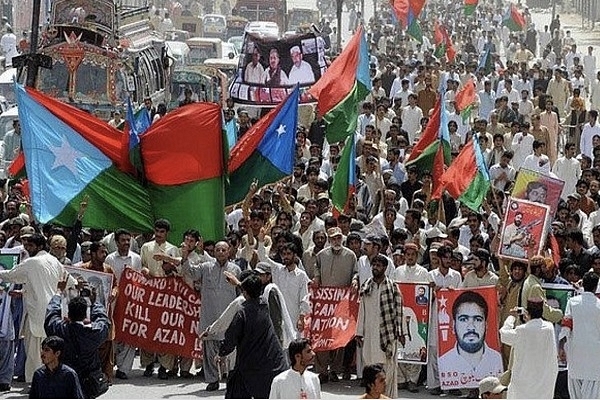News Brief
Balochistan Solidarity Day: History Of Annexation, Occupation And Exploitation In Pakistan’s Largest Province

A pro-independence Baloch rally. (@Nasiralbalushi7/Twitter)
Balochistan, an expansive arid and mountainous region spread across the modern-day countries of Pakistan, Iran and Afghanistan, has historically found itself squeezed between competing great powers due to its geographical position, struggling and fighting to maintain its autonomy against aggressive empires.
Soon after the British Raj ended, the historical precedent of foreign control turned into outright oppressive occupation for the people of the portion of Balochistan in modern-day Pakistan. During the period of the Raj, the territory was divided into a directly administered ‘Baluchistan Agency’ and a federation of sovereign princely states led by the Khanate of Kalat.
During independence negotiations, the Pakistani side agreed to respect the desire of Baloch states to maintain their independence and a Standstill Agreement was signed to that effect.
Soon thereafter, the Khan of Kalat declared the independence of Kalat state, including its feudatories of Las Bela, Kharan, Makkoran; the newly created nation was even able to hold democratic elections to its lower House (part of a bicameral legislature).
By this time, Mohammed Ali Jinnah, widely regarded as the founder of Pakistan, changed his earlier soft approach towards Balochistan. Officials from the Pakistani government began to pressurise the Kalat state to merge with Pakistan, although both Houses of the Kalat legislature overwhelmingly rejected such a move.
By 18 March 1948, Pakistan was able to convince/pressurise the feudatories of Las Bela, Kharan, Makkoran to accede to Pakistan. Abandoned by the sardars of his feudatories, the Khan of Kalat, Mir Ahmad Yar Khan himself succumbed to the pressure to join Pakistan and acceded on 27 March 1948.
Many Baloch nationalists did not take this acquiescence of the Khan lying down; the ruler’s own brother, Prince Abdul Karim, initiated a revolt against the coerced merger with Pakistan, resulting in the Pakistan Army’s brutal occupation of Balochistan to stifle the pro-independence factions.
Since then, the Balochistan freedom struggle has seen five phases of sporadic fighting, with the latest round continuing from 2003 onwards. In response to the Baloch people’s resistance against the rapacious exploitation of the province’s natural resources, the Pakistan Army has responded with mass-scale forced disappearances, extensive use of torture, civilian killings and other brutal tactics.
Apart from subjecting the province to relentless resource exploitation, the Pakistani state has wholeheartedly welcomed its Jihadist proxies fighting in Afghanistan to set up base in Balochistan. The Taliban’s ruling council itself is known as the Quetta Shura, as it has its headquarters in Balochistan’s capital city of Quetta.
Even as the Rawalpindi-Islamabad ruling class uses Balochistan as a means to its economic and strategic ends, the Baloch people continue to suffer— the province remains the most backward in the whole country, having the lowest literacy rate, highest infant mortality rate, lowest average incomes and many other glaringly bleak HDI indicators.
Support Swarajya's 50 Ground Reports Project & Sponsor A Story
Every general election Swarajya does a 50 ground reports project.
Aimed only at serious readers and those who appreciate the nuances of political undercurrents, the project provides a sense of India's electoral landscape. As you know, these reports are produced after considerable investment of travel, time and effort on the ground.
This time too we've kicked off the project in style and have covered over 30 constituencies already. If you're someone who appreciates such work and have enjoyed our coverage please consider sponsoring a ground report for just Rs 2999 to Rs 19,999 - it goes a long way in helping us produce more quality reportage.
You can also back this project by becoming a subscriber for as little as Rs 999 - so do click on this links and choose a plan that suits you and back us.
Click below to contribute.
Latest